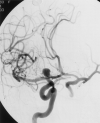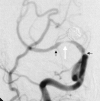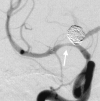In-stent stenosis as a delayed complication of neuroform stent-supported coil embolization of an incidental carotid terminus aneurysm
- PMID: 15569743
- PMCID: PMC8148720
In-stent stenosis as a delayed complication of neuroform stent-supported coil embolization of an incidental carotid terminus aneurysm
Abstract
The Neuroform stent is the first microcatheter-delivered stent designed specifically for the treatment of cerebral aneurysms. The stent functions primarily to provide durable parent vessel protection during the embolization of broad-necked cerebral aneurysms. The present case report demonstrates in-stent stenosis occurring as a delayed complication of Neuroform stent-supported coil embolization of an unruptured cerebral aneurysm.
Figures





Similar articles
-
Single-center experience with the Neuroform stent for endovascular treatment of wide-necked intracranial aneurysms.Surg Neurol. 2009 Dec;72(6):612-9. doi: 10.1016/j.surneu.2009.03.038. Epub 2009 Jul 14. Surg Neurol. 2009. PMID: 19604557
-
Treatment of wide-necked intracranial aneurysms with a self-expanding stent system: initial clinical experience.AJNR Am J Neuroradiol. 2003 Jun-Jul;24(6):1192-9. AJNR Am J Neuroradiol. 2003. PMID: 12812954 Free PMC article.
-
Balloon-in-stent technique for the constructive endovascular treatment of "ultra-wide necked" circumferential aneurysms.Neurosurgery. 2005 Dec;57(6):1218-27; discussion 1218-27. doi: 10.1227/01.neu.0000186036.35823.10. Neurosurgery. 2005. PMID: 16331170
-
Retreatment of recanalized aneurysms after Y-stent-assisted coil embolization with double enterprise stents: case report and systematic review of the literature.Turk Neurosurg. 2014;24(4):593-7. doi: 10.5137/1019-5149.JTN.9288-13.0. Turk Neurosurg. 2014. PMID: 25050689
-
Flow-Diverter Stent for an Unruptured Aneurysm at the Junction of the Internal Carotid Artery and Persistent Primitive Trigeminal Artery: Case Report and Literature Review.World Neurosurg. 2019 Dec;132:329-332. doi: 10.1016/j.wneu.2019.08.199. Epub 2019 Sep 5. World Neurosurg. 2019. PMID: 31493612 Review.
Cited by
-
The safety and effectiveness of the LVIS stent system for the treatment of wide-necked cerebral aneurysms: final results of the pivotal US LVIS trial.J Neurointerv Surg. 2019 Apr;11(4):357-361. doi: 10.1136/neurintsurg-2018-014309. Epub 2018 Oct 8. J Neurointerv Surg. 2019. PMID: 30297543 Free PMC article. Clinical Trial.
-
Self-expanding stents for recanalization of acute cerebrovascular occlusions.AJNR Am J Neuroradiol. 2007 May;28(5):816-22. AJNR Am J Neuroradiol. 2007. PMID: 17494649 Free PMC article.
-
Experiences of neuroform stent applications for ruptured anterior communicating artery aneurysms with small parent vessel.J Korean Neurosurg Soc. 2010 Jul;48(1):53-8. doi: 10.3340/jkns.2010.48.1.53. Epub 2010 Jul 31. J Korean Neurosurg Soc. 2010. PMID: 20717512 Free PMC article.
-
Clipping versus coiling for treatment of middle cerebral artery aneurysms: a retrospective Italian multicenter experience.Neurosurg Rev. 2022 Oct;45(5):3179-3191. doi: 10.1007/s10143-022-01822-3. Epub 2022 Jun 4. Neurosurg Rev. 2022. PMID: 35665868 Free PMC article.
-
Endovascular occlusion of intracranial wide-necked aneurysms with stenting (Neuroform) and coiling: mid-term and long-term results.Neuroradiology. 2009 Jun;51(6):401-9. doi: 10.1007/s00234-009-0502-2. Epub 2009 Feb 25. Neuroradiology. 2009. PMID: 19241069
References
-
- Lowe HC, Oesterle SN, Khachigian LM, et al. Coronary in-stent restenosis: current status and future strategies. J Am Coll Cardiol 2002;39:183–193 - PubMed
-
- Kearney M, Pieczek A, Haley L, et al. Histopathology of in-stent restenosis in patients with peripheral artery disease. Circulation 1997;95:1998–2002 - PubMed
-
- Hoffman R, Mintz GS, Dussaillant RG, et al. Patterns and mechanisms of in-stent restenosis: a serial intracascular ultrasoulnd study. Circulation 1996;94:1247–1254 - PubMed
-
- Fiorella D, Albuquerque FC, Han P, McDougall CG. Preliminary experience using the Neuroform stent for the treatment of cerebral aneurysms. Neurosurgery. 2004;54:6–16 - PubMed
-
- Lylyk P, Cohen JE, Ceratto R, et al. Endovascular reconstruction of intracranial arteries by stent placement and combined techniques. J Neurosurg 2002;97:1306–1313 - PubMed
Publication types
MeSH terms
LinkOut - more resources
Full Text Sources
Other Literature Sources
Medical
